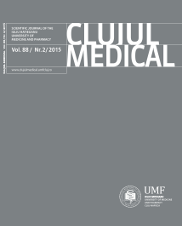Unilateral peripheral vestibular disorders in the emergency room of the ENT Department of Cluj-Napoca, Romania
DOI:
https://doi.org/10.15386/cjmed-412Keywords:
peripheral vestibular, ENT emergency room, algoritm, vertigo, dizzinessAbstract
Objective: To asses the management of unilateral peripheral vestibular disorders in the emergency room of the ENT Department of Cluj-Napoca, Romania.
Material and method: The study was prospective, non-randomized and included the patients presented for dizziness or balance disorders at the emergency room of the ENT Department between March 2012 and March 2013. Demographic characteristics, specific clinical history, the onset of peripheral vestibular disorders, and co-morbidities were recorded. The patients charts included the type of onset and the treatment (medical, surgical, and rehabilitation) performed in the emergency room or in case of hospital admission, the relieving measures for the vestibular symptoms with or without hearing recovery.
Results: One hundred and fifty-two subjects were included in our study, 97 with pure peripheral vestibular dysfunction (VD), 34 with cochlear-vestibular dysfunction (CVD), and 21 with Ménière’s disease (MD). No significant differences were identified when the proportion of patients with a certain onset (acute, subacute or chronic) were compared. Hypertension was the most frequent co-morbidity in all investigated groups. No significant difference was observed when the relief of vertigo or hearing recovery were compared between all groups.
Conclusion: This first Romanian report on the management of unilateral peripheral vestibular disorders showed that early corticosteroids treatment associated with electrolytes, antiemetic, and vasodilation drugs led to produces recovery of the vestibular function without any differences between the types of peripheral vestibular dysfunction. In addition, we obtained the complete recovery of the vestibular and acoustic dysfunction in the cases treated with metylprednisolone intratympanic injection.
Downloads
Published
How to Cite
Issue
Section
License
The authors are required to transfer the copyright of the published paper to the journal. This is done by agreeing to sign the Copyright Assignment Form. Whenever the case, authors are also required to send permissions to reproduce material (such as illustrations) from the copyright holder.

The papers published in the journal are licensed under a Creative Commons Attribution-NonCommercial-NoDerivatives 4.0 International License.

